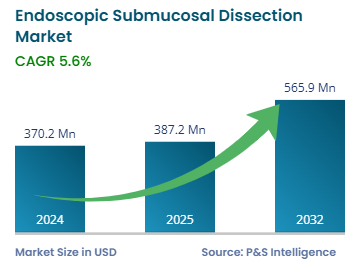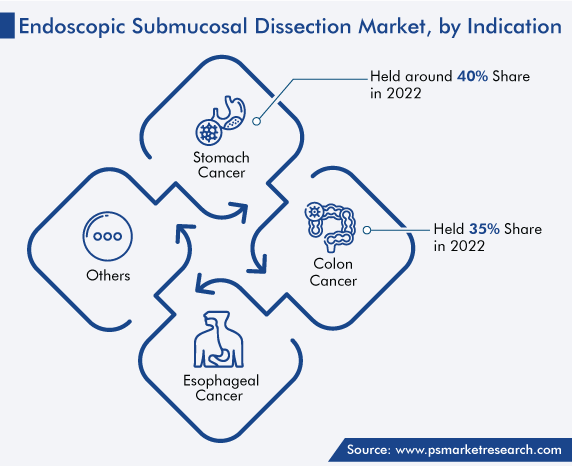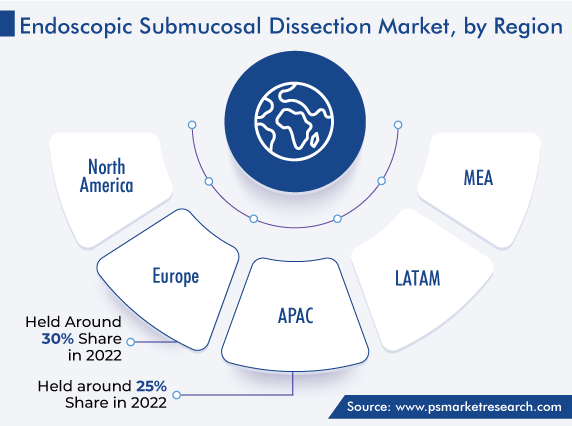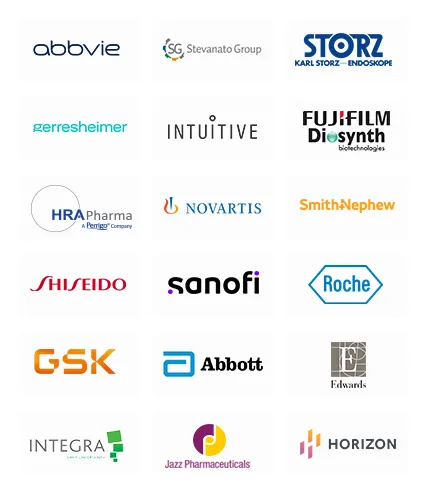Market Statistics
| Study Period | 2019 - 2030 |
| 2024 Market Size | USD 370.2 Million |
| 2030 Forecast | USD 512.9 Million |
| Growth Rate(CAGR) | 5.6% |
| Largest Region | Europe |
| Fastest Growing Region | North America |
| Nature of the Market | Consolidated |
Report Code: 12638
Get a Comprehensive Overview of the Endoscopic Submucosal Dissection Market Report Prepared by P&S Intelligence, Segmented by Product (Gastroscopes and Colonoscopes, Knives, Injection Agents, Tissue Retractors, Graspers/Clips), Indication (Stomach Cancer, Colon Cancer, Esophageal Cancer), End User (Hospitals, Specialty Clinics, Ambulatory Surgical Centers), and Geographic Regions. This Report Provides Insights from 2019 to 2030.
| Study Period | 2019 - 2030 |
| 2024 Market Size | USD 370.2 Million |
| 2030 Forecast | USD 512.9 Million |
| Growth Rate(CAGR) | 5.6% |
| Largest Region | Europe |
| Fastest Growing Region | North America |
| Nature of the Market | Consolidated |

Explore the market potential with our data-driven report
The global endoscopic submucosal dissection market was valued at USD 370.2 million in 2024, and the market size is predicted to reach USD 512.9 million by 2030, advancing at a CAGR of 5.6% between 2024 and 2030. The market is driven by the rising incidence of targeted diseases, increasing use of endoscopies for disease detection and treatment, and growing geriatric population.
Endoscopic submucosal dissection (ESD) procedures are used to remove various lesions and tumors in the submucosa. It is comparatively more effective for eliminating certain growths that have clear borders or those that are too large to remove in one piece by other methods. In these cases, ESDs can help in minimizing the risk of the spread of cancer. In Japan, this procedure, which involves a large and deep esophageal wall resection via the dissection of the submucosal connective tissue just beneath the target lesion from the underlying muscle layer, with the help of electrocautery devices, such as a hook knife, is becoming increasingly popular.
Endoscopists have started to accept this procedure worldwide, although it is the most frequently performed in APAC, especially for the early neoplasia of the esophagus, stomach, colon, and rectum. Its key benefit is the ability to remove larger lesions en bloc in the plane between the muscularis propria and the submucosa. There are many forms of ESDs, including endoscopic submucosal tunneling, or, in select cases, even a full-thickness resection.
As the geriatric population is increasing, a rise in the number of patients riddled with target diseases and those being getting treated with antithrombotic drugs has been seen. The ESD is a comparatively safe technique on super-elderly patients suffering from early-stage gastric cancer. It is less invasive than open surgical procedures and highly advantageous in terms of organ preservation.
Stomach cancer held the largest share in 2022. This is mainly due to the intake of large amounts of foods preserved by salting, such as salted fish and meats and pickled vegetables. In the U.S., stomach cancer is one of the leading causes of death; each year, it accounts for almost 2% of all new cancers. In the country, stomach cancer primarily begins in the gastroesophageal junction.
Moreover, obesity is one of the key causes of stomach cancer. In the U.K., around 5 out of 100 stomach cancers are caused due to overweight or obesity. In 2021, more than 25% of the adults in the U.K. were obese, and a further around 40% were overweight. Additionally, each year, Japan organizes a national endoscopic surveillance program due to the high stomach cancer risk. It has been suggested that every year, people who are older than 40 years undergo screening with endoscopy and a double-contrast barium X-ray.

Hospitals held the largest share, of 60%, in 2022, due to the fact that various hospitals worldwide are opting for this procedure as it less invasive. For instance, in February 2023, Mediclinic Parkview Hospital in the U.A.E. launched endoscopic submucosal dissection services. This new minimally invasive procedure will positively impact the wellbeing of patients who could require surgical intervention, such as a colon, esophageal, or stomach resection, which can lead to further lifestyle complications.
Moreover, in 2020, in India, KMC Hospital performed an endoscopic procedure on a large tumor, which was present in the stomach of a 40-year-old woman. The tumor was removed via the mouth, without any surgery and external scar.
Further, various investments are being done in this area to make the procedure easily accessible, more effective, and safer. For instance, in 2021, Scope Investment, a private investment firm based in the U.A.E., partnered with the Asan Medical Center (AMC) Hospital in South Korea to open GCC’s first comprehensive GI hospital in the U.A.E. for GI cancer procedures, such as ESD, EMR, and ERCP.
The knives category is expected to grow the fastest, with a global endoscopic submucosal dissection market CAGR of around 6.5%, in the forecast period. This will mainly be due to the availability of a wide range of surgical knives, which are, additionally, evolving rapidly for higher efficacy, safety, and cost-effectiveness. A variety of combination of I knives and O knives are available to resect different kinds of tissues.
Moreover, tissue retractors also held a significant share in the market. This is mainly attributed to the increasing number of surgical procedures and technological advancements, including robotic surgery, telesurgery, and multi-angle rear-viewing endoscopic tool (MARVEL). Surgical robots consist of several arms, one with a camera and others attached to surgical instruments. These robots provide more precision for a more-minimally invasive procedure, as well as faster recoveries, smaller incisions and scars, and reduced blood loss and risk of infections.
Of late, telesurgery has been one of the greatest advancements in the field of surgery. With this, surgeons can operate from anywhere, with the help of surgical robots. This technology has become even more popular during the COVID-19 outbreak.
Drive strategic growth with comprehensive market analysis
APAC held around 25% share in 2022, mainly because of the high prevalence of gastric cancer in the region. China ranks fourth and third in the world in gastric and esophageal cancer occurrence, respectively.
Due to its large population, the country has a significant number of patients with gastric and esophageal cancer. Thus, every year, the Government of China organizes an upper gastrointestinal cancer screening program in high-incidence rural areas. In this program, both the stomach and esophagus are inspected in a single endoscopy, for early cancer detection. This program covers most of the provinces of China.
The Chinese government also organizes other programs to prevent death from this type of cancer, such as the Cancer Early Diagnosis Program, Early Treatment Program in the Huai River Basin, and the Cancer Early Diagnosis and Early Treatment Program in Urban China.
Gastric cancer is the second major cause of cancer death globally. In 2021, a new study confirms that in China, the major cause of stomach cancer is an infectious bacterium H. pylori.
Moreover, the geriatric population has been continuously increasing in Japan Since 1950. In 2022, there were around 80,000 centenarians, while by 2036, people aged 65 and more will represent a third of the population. Additionally, elderly women numbered more than 20 million, accounting for more than 32% of the total female population, and the elderly male population stood at around 16 million, accounting for more than 25% of the overall male population.
Moreover, Europe holds around 30% in the market. The incidence of chronic diseases is on the rise in the region due to the sedentary lifestyles and many other external factors, which has increased the demand for the diagnosis and treatment of diseases of the gastrointestinal, cardiopulmonary, and urological systems. There were about 4 million new cancer cases and about 1.9 million related deaths in Europe in 2020.
In Western European countries, such as Spain, Germany, Italy, and Norway, there has been a constant rise in the incidence of cancer and GI diseases. Some of the highly prevalent diseases in the region that are diagnosed with endoscopies are peptic ulcer disease, colon polyps, colitis, colorectal cancer, and pancreatitis. Moreover, patients are shifting toward endoscopic surgeries to avoid the traditional approaches, which require a large incision, or even a laparotomy in extreme cases. Compared to traditional approaches, endoscopy-guided minimally invasive surgeries result in less pain and scarring, a faster recovery, and a lower risk of complications.
Moreover, the growth in the network of hospitals and ASCs in the region helps in the market advance. Approximately 25,000 hospitals are present in Europe, which are hosting more patients every year. Further, healthcare practitioners are becoming inclined toward minimally invasive surgeries, which propels the usage of endoscopes. In addition, companies operating in the market are actively collaborating to capture a significant position and expand their geographical footprint.

Based on Product
Based on Indication
Based on End User
Geographical Analysis
The market for endoscopic submucosal dissection products will witness a CAGR of 5.6% during 2024–2030.
The endoscopic submucosal dissection industry valued USD 370.2 million in 2024.
The demand for knives is rising the fastest in the market for endoscopic submucosal dissection products.
Stomach cancer leads the endoscopic submucosal dissection industry.
North America and Europe holds major share in the endoscopic submucosal dissection market.
Want a report tailored exactly to your business need?
Request CustomizationLeading companies across industries trust us to deliver data-driven insights and innovative solutions for their most critical decisions. From data-driven strategies to actionable insights, we empower the decision-makers who shape industries and define the future. From Fortune 500 companies to innovative startups, we are proud to partner with organisations that drive progress in their industries.


Working with P&S Intelligence and their team was an absolute pleasure – their awareness of timelines and commitment to value greatly contributed to our project's success. Eagerly anticipating future collaborations.
McKinsey & Company
IndiaOur insights into the minutest levels of the markets, including the latest trends and competitive landscape, give you all the answers you need to take your business to new heights
We take a cautious approach to protecting your personal and confidential information. Trust is the strongest bond that connects us and our clients, and trust we build by complying with all international and domestic data protection and privacy laws
Customize the Report to Align with Your Business Objectives
Request the Free Sample Pages